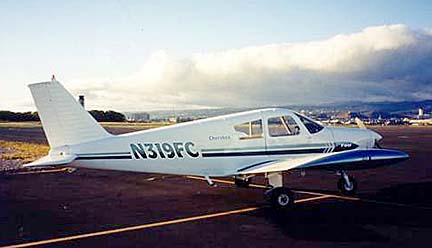


NTSB finds no An investigator looking into last week's plane crash on Lanai will be spending the next two days trying to determine whether environmental or human factors contributed to the fatal accident.
problems with
plane in Lanai crash
Investigators are now turning
their attention to environmental
and human factorsBy Treena Shapiro
tshapiro@starbulletin.comTealeye Cornejo, an air safety investigator with the National Transportation Safety Board, arrived in Honolulu yesterday after spending two days on Lanai surveying the crash scene.
Working with representatives of the airplane's frame and engine manufacturers, Cornejo said they have found no mechanical problems with the aircraft. Fuel was found in the plane's left wing. No similar determination could be made from the right wing because it had ruptured.
"Nothing is wrong that we could find," she said.
Navy Petty Officer 2nd class Matthew Monczynski, 23, was killed when the Piper Cherokee 28-140 aircraft crashed on a plateau 412 miles northwest of Lanai Airport. Monczynski may have been taking a flying lesson at the time of the crash.
Before she leaves tomorrow, Cornejo hopes to speak with 22-year-old Matthew McGurk, a certified flight instructor who survived the crash, as well as the flight school that owned the plane. She will also examine records and radar data.
McGurk, who is in fair condition at Queen's Medical Center following surgery last night, may be able to answer questions key to the investigation. At this point it is unknown who was actually flying the plane, as it can be controlled from either of the two front seats. Both seats were found outside the plane; Monczynski had been sitting in the right seat.
Cornejo said when McGurk is interviewed, he will be asked about the circumstances, then she will "listen to his story." She hopes to learn the purpose of their flight, how long they had been flying, whether they had landed at Lanai and what they were doing at the time of the accident.
Cornejo said it is unclear whether the plane had been taking off or landing. The plane came to rest facing toward the airport, but impressions left by the landing gear -- which is permanently down -- indicate the plane had been traveling toward Honolulu. The tracks left by the landing gear extend for 50 feet across the plateau before hitting a berm.
Cornejo said there had been no distress call, and the pilot had called Honolulu to close their flight plan. Cornejo said it is not unusual for pilots to tell whoever they filed their flight plan with that they have reached their destination, regardless of whether they have landed.
Investigators will also look into environmental factors. Cornejo said the Coast Guard estimated that the plane had gone down at about 8:30 p.m. Thursday, although that has not been confirmed. On Friday night the Coast Guard said a rescue beacon was picked up at about 12:15 Friday morning in the ocean six miles southeast of Lanai.
Coast Guard spokesman Gary Openshaw said the rescue beacon was an older model and that it sometimes takes a while for satellites to pick up the signal.